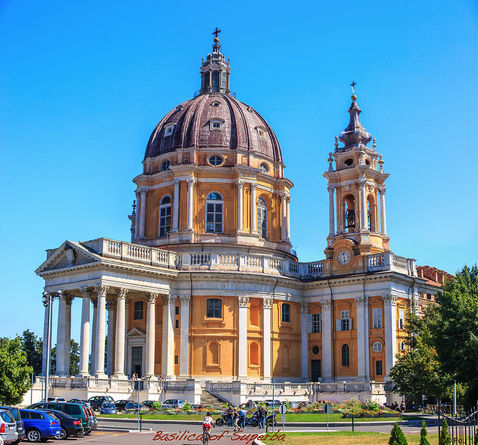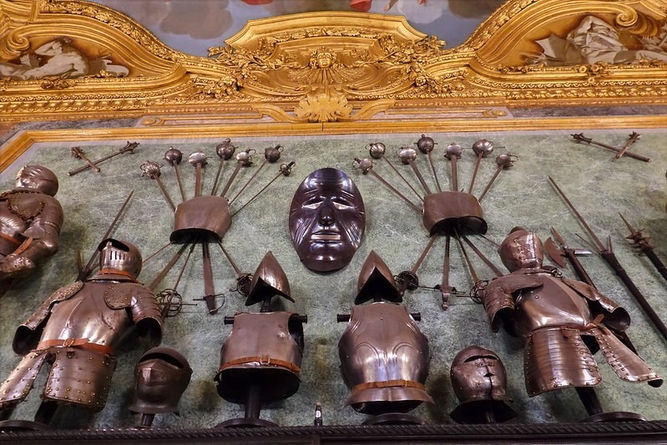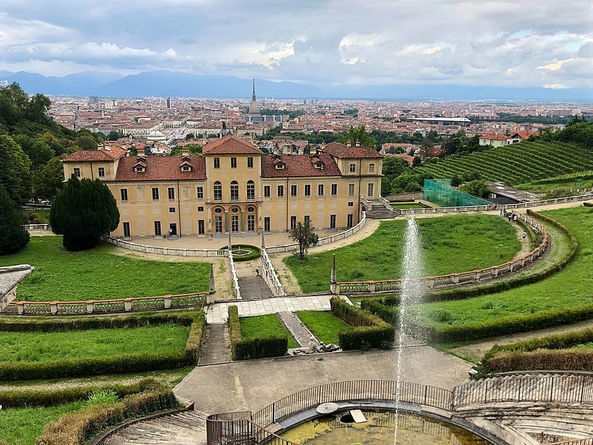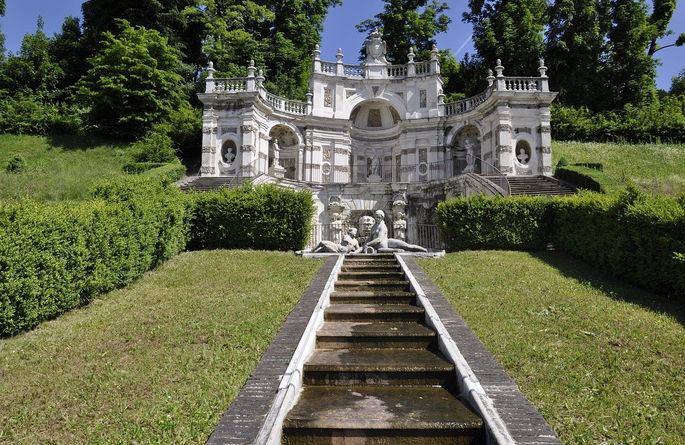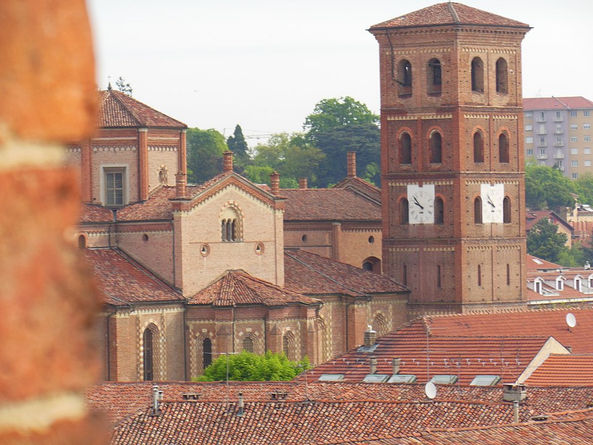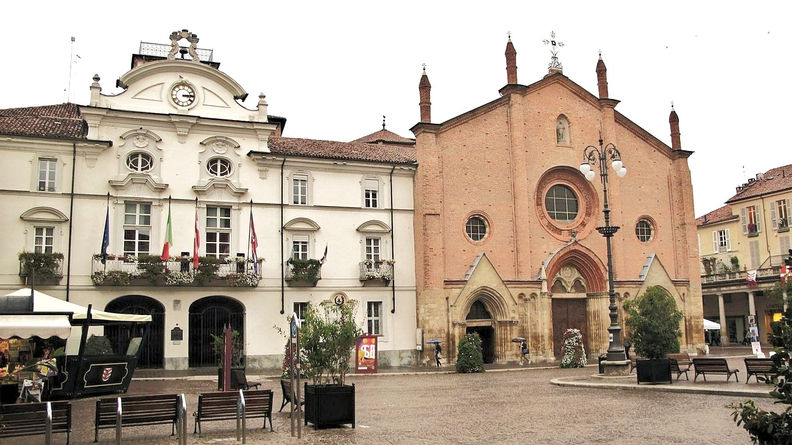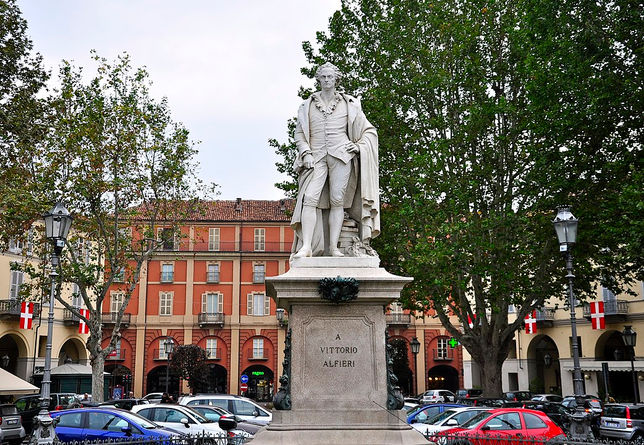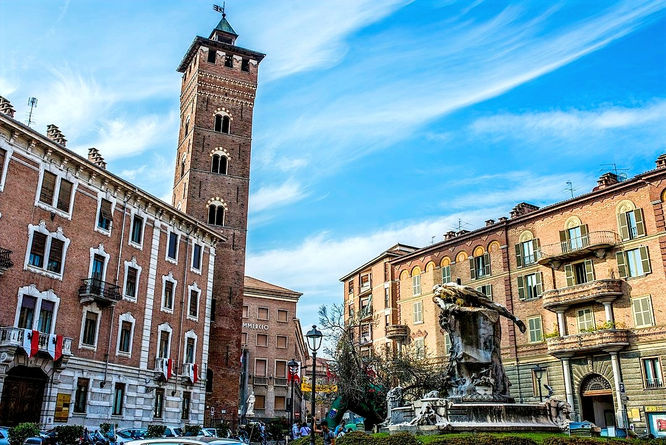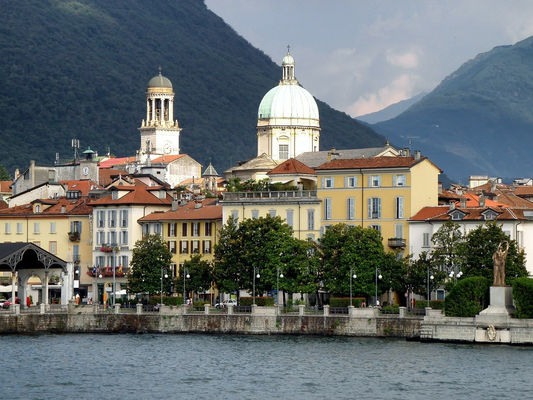
皮埃蒙特

皮埃蒙特是意大利西北的一个大区。位于波河上游谷地, 三面被阿尔卑斯山山脉包围,南是利古里亚亚平宁山脉。大区首府是都灵。其他主要城市包括: 阿尔巴Alba, 亚历山德里亚 Alessandria, 阿斯蒂Asti, 库内奥Cuneo, 伊夫雷亚Ivrea, 马焦雷湖 Lake Maggiore,朗格 Langhe, 蒙费拉托Monferrato, 诺瓦拉 Novara, 塞拉瓦莱斯克里维亚Serravalle Scrivia, 斯特雷萨 Stresa, 韦尔巴尼亚Verbania, 、韦尔切利Vercelli。
皮埃蒙特的低地是一块农产丰足的地区,盛产小麦、稻米、牛肉、葡萄及秋季的松露也闻名。松露的那股独特浓香令人回味无穷。 皮埃蒙特大区精致的葡萄酒和美食传统享誉世界,已成为意大利卓越品质的象征之一。该区出产的Barolo红酒有“意大利酒王”之誉。该区 享有巧克力之都的美名。世界首家巧克力工厂Caffarel,于1826年在都灵诞生。这里生产大量的榛子, 所以1865年,发明了意大利的榛果巧克力Gianduj。
著名的巧克力公司费列罗集团也源自这里。该区也是主要的工业中心,其中都灵也是菲亚特车厂的总部所在地。
在这里你既能品尝到各种当地的风味美食,同时还可欣赏到充满魅力的奇特美景, 岂不赛过神仙。
皮埃蒙特有五个联合国教科文组织遗产, 即:
-
20世纪伊夫雷亚工业城
-
阿尔卑斯山周围的史前桩民居(与伦巴第、特伦蒂诺-上阿迪杰共享)
-
萨伏依王室居所 (都灵与皮埃蒙特王宫建筑群)
-
皮埃蒙特的葡萄园景观:朗格 - 罗埃罗和蒙费拉托
-
皮埃蒙特和伦巴第的 9 座圣山(7座位于皮埃蒙特 7,2座位于伦巴第 )
By Nicolae Baltatescu - Pixabay
都灵
都灵,意大利的第三大城市, 位于波河边,在风景如画的蒙费拉托山上。 1861 年都灵成为意大利统一之后的第一个首都,1865 年首都迁至佛罗伦萨,1870 年最终迁至罗马。都灵现在是皮埃蒙特地区的首府。
这座历史悠久的古城,萨伏依王国的首都,至今仍保存着大量的古典式建筑、巴洛克、洛可可和新古典主义法式建筑。这座古老的城市还被称为意大利最甜的地方,意大利三分之一的巧克力制造工厂位于此,享有巧克力之都的美名。此外,这里还是欧洲最大的汽车产地,世界十大汽车公司之一 “菲亚特的故乡”。这里也是意甲两大球队都灵和尤文图斯的主场!
都灵葱郁美景将为您的观光之旅增添无限乐趣。美丽的绿树成荫大道遍布着许多咖啡馆,随意走几步就是一间咖啡厅或餐厅,到处弥漫着浓浓的咖啡香味。罗马街(Via Roma)是都灵古代历史中心最重要的一条街道,
街道两侧有拱廊,是为了让贵族们冬天不湿身,夏天不晒太阳而建造的。
街上店铺琳琅满目,大大小小的品牌店分布在街上。热闹的街区,这里不仅是游客的购物天堂,也是本地居民最爱逛的地方。
古典与活力,在这一处就可以完全体验!
圣乔瓦尼大教堂和圣裹尸布教堂 Cathedral of St. John the Baptist and the Chapel of the Holy Shroud
圣乔瓦尼大教堂是都灵的主教堂,始建于15世纪,紧挨着都灵王宫,因收藏着传说中的圣物——耶稣裹尸布而出名。裹尸布在那里保存了 400 多年。但是裹尸布常年被保存在教堂内,每十年展出一次(上次是2015年展出),所以平时只能看到照片和影像介绍,很难看见实物。裹尸布的复制品在教堂前的祭坛上永久展出。
1997 年,教堂被一场大火严重破坏, 但裹尸布幸免于难。 随后,它对公众关闭,历时 21 年,耗资 3000 万欧元才恢复到原来的辉煌。 2018 年 9 月 27 日,圣裹尸布教堂重新向公众开放。
都灵裹尸布 The Shroud of Turin
都灵裹尸布是一块亚麻布,前后的印记表明曾用于包裹一名身材高大,长发蓄须的男子,他的双脚、手腕和身体两侧有伤,向外渗出血水。据说,耶稣在十字架上被钉死之后、复活之前,尸体就是用它包裹、下葬的。尽管 600 年前,教皇克莱门特七世宣布裹尸布是假的,,但许多人仍然相信它是真迹, 它是世界各地基督徒的重要宗教象征。
裹尸布不向公众开放。上一次公开展示是在 2015 年,下一次公开展示是在 2025 年。
然而,在 2020/21 年 4 月的复活节,裹尸布进行了虚拟展示,都灵大主教切萨雷·诺西利亚在裹尸布前祈祷,并邀请世界各地的信徒从家里加入,为冠状病毒祈祷。
埃及博物馆 Egyptian Museum
都灵的埃及博物馆是世界第二大的埃及博物馆,被公认为继开罗的埃及博物馆之后最好的古埃及原始工艺品博物馆。里面展出了大量值得观看的艺术珍宝,收藏了近3万件珍贵文物,记载了古埃及由旧石器时代到科普特时代的文化和历史。
安东内列纳尖塔 Mole Antonelliana
另一座杰出的建筑是安东内列纳尖塔,是都灵的地标性建筑。它原本是都灵的犹太教堂,目前塔内设立的国家电影博物馆。透明的观光电梯就好似观景台,59秒内将游客带上85米高的塔顶,这里是欣赏意大利阿尔卑斯山、波河河谷及都灵城市美景的最佳地点。
苏佩尔加大教堂 Basilica of Superga
苏佩尔加大教堂,位于都灵附近的苏佩尔加山上,是一座气势宏伟的巴洛克风格的教堂。这里可以欣赏到都灵市的壮丽景色,值得一游。
萨伏依王室居所世界文化遗产 Residences of the Royal House of Savoy UNESCO World Heritage Sites
萨伏依王室居所是皮埃蒙特的一处世界文化遗产,由22 座建筑组成,是萨伏依王室优雅的住宅,包括都灵及其附近的多所建筑。萨伏依王室是意大利统一运动的主力,在意大利统一之后,都灵也曾是意大利的首都。萨沃王宫包括了都灵王宫、夫人宫、卡里尼亚诺宫、瓦伦蒂诺城堡、雷吉纳别墅、斯杜皮尼吉行宫、维纳利亚宫、蒙卡列里城堡、利沃利城堡、阿列城堡、拉科尼吉城堡、戈沃内城堡等建筑。
这些建筑具有重要的历史,展示着萨伏依王朝艺术品位的流变。 该建筑群于 1997 年被联合国教科文组织列为世界文化遗产。快来探索,体验令人惊叹的景色和非凡的文化遗产,走入皇家般的风光,回想这座古都的昔日繁华。
最重要的建筑无疑是都灵皇宫(Palazzo Reale)。这气势雄伟的皇宫是萨伏依皇室的居住地。皇宫建筑风格奢华,各个房间都按照萨伏依王朝贵族的口味进行了装饰。宫中收藏着众多拥有数百年历史的君主物品。其中有很多的钟表、瓷器、银器及各种古代家具。宫殿门的门廊之下的皇家军械库还藏有大量15和19世纪的武器,是欧洲最大的收藏之一 。皇宫的西翼,有螺旋圆顶的裹尸布礼拜堂,连接都灵主教座堂的后殿,那里收藏着著名的都灵耶稣裹尸布。皇宫后花园也十分著名,由凡尔赛花园的设计者Andre设计。皇家花园里有个古代博物馆展示了从史前时代到罗马时代晚期的考古发现。都灵皇宫是保存最完好的欧洲宫殿之一。
夫人宫(Palazzo Madama),一个迷人、美丽的宫殿,矗立在城市的中心,是古代艺术市民博物馆的所在地。卡里尼亚诺宫(Palazzo Carignano ), 位于都灵最大的公园 Parco Valentino 内,这是巴洛克艺术在都灵体现得最好的例子, 现在是复兴运动国家博物馆和瓦伦蒂诺城堡(都灵理工大学建筑学院的所在地),这是一个带阴凉人行道的浪漫公园,靠波河岸边。这是一个悠闲散步的好地方!另一个不容错过的是迷人的女王别墅 (Villa della Regina),这是一座 17 世纪的宫殿,坐落在都灵山坡的绿色植物中,周围环绕着大型葡萄园和果园。它曾是皇室女士和萨伏依家族的夏宫。 女王别墅 拥有都灵自己的城市葡萄园,生产优质的红葡萄酒 Freisa di Chieri DOC。
都灵省周边地区有位于La Mandria 公园内的博尔戈城堡 (Borgo Castello)、维纳利亚皇宫(Royal Palace of Venaria),华丽和极其迷人的建筑结构,最初被认为是一个狩猎时的居所,但现在,在都灵甚至是意大利它都是最重要的艺术和文化遗址。一年四季每天都在进行音乐会、展览、文化和娱乐活动。还有优雅静谧的蒙卡列里城堡(Royal Castles of Moncalieri)、利沃利城堡(Rivoli )和 阿列(Aglié) 的皇家城堡,以及 斯图皮尼基猎宫(Stupinigi )的狩猎小屋,这是个狩猎居所,是萨伏依家族举办庆典和婚礼最喜欢的地方之一。
在库内奥省,有拉科尼吉皇家城堡,建筑风格多样,波伦佐城堡和戈沃内城堡拥有丰富的木制家具和装饰品,以及瓦尔卡索托的别墅,不过此别墅正在进行长时间的修复,不对游客开放。
萨伏依王室的一个特殊之处在于其奢华的皇家公园,漫步在花园中,高大青翠的树木、绚烂开放的鲜花、潺潺水声、优雅的景观,令人唤起宁静的片刻!
伊夫雷亚
伊夫雷亚位于意大利西北部皮埃蒙特区,临近工业重镇都灵。虽然不是主要的旅游目的地,但联合国教科文组织认为它是20世纪工业革命发展的理想之地,是工业化社会发展模式的一个典范。遗产地包括好利获得一座大型工厂和用于行政、社会服务及住宅用途的建筑群。意大利电气工程师卡米洛·奥利韦蒂Camillo Olivetti1908年在伊夫雷亚创立以打字机制造起家的资讯科技公司好利获得 Olivetti。Olivetti后来被卡米洛的儿子阿德里亚诺·奥利韦蒂Adriano Olivetti接掌,公司自此腾飞,业务从简单的打字机制造拓展至商业器材和电脑系统研发和生产,并在1930年代扩张至二十多个国家,而我们今天所看到的这座伊夫雷亚工业城就是30-60年代Olivetti公司的发展成果。伊夫雷亚被分割成两部分,一侧是伴随着多拉巴尔泰河潺潺流淌的古朴老城区,另一侧则是伫立着一排排厂房和办公楼的现代工业区。伊夫雷亚必访景点有好利获得大楼、伊夫雷亚城堡、主教宫和大教堂。
伊夫雷亚工业城 好利获得建筑群 Olivetti Building
伊夫雷亚工业城是由工业功能大楼和社会文化工程共同组成的建筑群。这里曾是打字机、机械计算机和办公电脑制造商好利获得(Olivetti)的试验场。沿着杰维斯大道 (Via Jervis),欣赏由意大利20世纪最著名的建筑设计师和城市规划师设计的 72,000 公顷的建筑。这些建筑是 Olivetti 行业的工人、董事和设计师的制造、社会服务和住房所需要的。2918年被列入 联合国教科文组织世界遗产名录。
伊夫雷亚城堡 Castello
伊夫雷亚城堡是伊夫雷亚老城的标志,建于14世纪,这座城堡曾经是一座避难所,如今是座展览厅。
伊夫雷亚大教堂 Cathedral
伊夫雷亚大教堂可以追溯到公元1世纪,古神庙和古剧院的遗迹依然可见。经过几次翻修,立面从古罗马式,变为布拉曼特式,到最后为新古典主义风格, 不过许多建筑还保留着中世纪时期的特色。其中包括半圆形后殿和两座罗马式钟楼、一些柱子,以及地下室的壁画。
阿尔巴
阿尔巴镇不仅以白松露而闻名,而且还是非常重要的葡萄酒生产中心。
阿尔巴白松露国际博览会从 10 月的第一周一直持续到 11 月的最后一周,为期两个月,这是阿尔巴最著名的活动之一。在此, 也可以感受浓郁的意大利风情。
阿尔巴的葡萄酒是意大利最优质的葡萄酒之一,分为:
• DOC:巴贝拉、多尔切托、内比奥罗。
• DOCG:巴巴莱斯科、巴罗洛、莫斯卡托。
起伏山丘上的葡萄园在任何季节都很美丽,但在秋天的景色美不胜收。有什么比亲自前往当地知名的葡萄酒庄里,一边欣赏绝美的田园风光,一边品尝自酿的葡萄酒再配上当地特色菜肴,瞬间幸福感爆棚!
除了是美食天堂之外,阿尔巴还是典型的中世纪防御城镇,12世纪哥特式的圣洛伦佐大教堂, 从教堂钟楼, 可以瞭望整个城市景观、 Federico Eusebio 博物馆收藏了从史前到罗马时代的文物,还有每个星期六的跳蚤市场,整个小镇都塞满了琳琅满目的小摊位,一家挨着一家,非常热闹。这里不仅是游客的购物天堂,也是本地居民最爱逛的地方。
亚历山德里亚
该省首府亚历山德里亚市位于博尔米达河和塔纳罗河之间,位于米兰(97 公里)、都灵(90 公里)和热那亚(86 公里)之间的工业三角中间。 如果您正在游览这三个城市,不要错过参观这座令人愉快的城市,您会为这座城市提供的一些独特事物感到惊讶。 亚历山德里亚以生产高品质帽子而闻名,尤其是 Borsalino 品牌,并在这座城市留下了深厚的遗产。
亚历山德里亚城堡
位于亚历山德里亚城市的西北角,作为反抗神圣罗马帝国皇帝的伦巴第联盟的堡垒始建于公元1168年,是一座恢弘的古迹,一座重要的防御工程, 。其防御工事呈美丽的几何图案,从高处俯瞰极为精致。同时它也是欧洲唯一一个没有改变其周边原始环境的堡垒。城堡大桥因洪水侵袭曾多次重建,不过还保留着当时的样貌。 从高处俯瞰极为精致。同时它也是欧洲唯一一座没有改变其周边原始环境的堡垒。
迈耶桥
迈耶桥横跨塔纳罗河,将市中心与亚历山德里亚城堡连接起来,是亚历山德里亚的标志性建筑。 这座桥由著名建筑师 Richard Meier 于 1990 年代建造,采用双重设计,包括一条公共道路和一条独立的人行道。 建筑和设计真的令人惊叹! 您可以使用这座桥穿越到 古堡城。
加里波第广场
加里波第广场是亚历山德里亚市中心最受欢迎的广场之一,拥有一些精美的建筑,还拥有大型市场。 广场四周环绕着拱形门廊,里面有许多很棒的商店和咖啡馆。
Cathedral of Alessandria
The cathedral of Alessandria has the second tallest tower in Italy. Opposite the church there is the Conservatory of Alessandria.
Palazzo Ghilini
Palazzo Ghilini, one of the best examples of 18th Century architecture in Italy and most important building in the city centre. A royal residence of the Ghilini family, whose history is intertwined with that of Alessandria. Although you cannot enter the palace, you can admire the architecture from the exterior . The front façade features a series of stone columns, windows with decorative pediments and a grand entrance.
Arch of Trionfo
Whilst walking through the town, visit the fantastic Arch of Trionfo, one of Alessandria’s most important monuments, constructed in the 18th century.
Galleria Guerci
The Galleria Guerci has a similar design to the well-known gallery in Milan and is a great place for shopping or to relax to sip an espresso! Corso Roma is the main shopping street, with many boutiques and a range of high end fashion brands.
Borsalino Hats Museum
Giuseppe Borsalino founded the factory in Alessandria in 1857 and soon its stylish fedoras and panama hats became an icon of ‘Made in Italy’ craftsmanship.
The Museo Cappello Borsalino provides insight into the history of the premier hat making factory and contains a wonderful display of over 2000 different pieces of headgear.
Asti
The province of Asti, is mostly hilly territory stretches across Monferrato and is traversed by the Tanaro River.
Gentle hills and valleys, created scenery of unique beauty, with vineyards stretch as far as the eye can see. Asti is best known for producing Asti Spumante and Moscato d’Asti, two celebrated sparkling white wines made from the Moscato Bianco grape, exported all around the world. You can savor them at any of the town’s many charming wine bars or venture to a nearby winery for a formal tasting.
Cathedrale of Santa Maria Assunta
The City of Asti is capital of the province. In the historical town, see the art work in Asti’s Gothic cathedral, the beautiful and impressive Cathedrale of Santa Maria Assunta, also known as the Duomo, has been built and rebuilt several times for over 700 years.
Piazza San Secondo
A lovely town square overlooking the Palazzo Civico (town hall)
Piazza Alfieri
Take a stroll through the lively, Piazza Alfieri, named after Italy's most renowned 18th-century poets, Vittorio Alfieri. It is lined by porticoed buildings and contains the marble and granite Vittorio Alfieri.
Like Siena in Tuscany, Asti also hosts one of Italy’s oldest Palio competitions (medieval horse races) in Piazza Alfieri, on the first Sunday in September since 1275, making it one of the oldest races of its kind in Italy!
Troyana Tower
During the late 13th century, Asti became one of Italy's wealthiest city, with 150 towers springing up, thus, Asti was known as "the city of 100 towers". Of the 15 that remain today, only Troyana Tower, 38m-tall tower is open to public. A climb to the top promises magnificent views of the city and its surrounding countryside. The clock was added in 1420.
Biella
The province of Biella is a green area surrounded by the Alps.
The city of Biella, capital of the province, is spread over several levels, The oldest part Piazza Duomo is where the Romanesque Baptistery rises; the Renaissance complex of San Sebastiano, whose cloister is now home to the Museo del Territorio Biellese. The medieval village of Piazzo, located in the upper part of Biella, can be reached using the historic funicular that offers a picturesque panorama of the city. Biella is an important wool processing and textile centre. Biella produce fine yarns and fabrics of excellence quality. It is the headquators of famous Cerruti 1881 (men,s wear), Ermenegildo Zegna (men'swear) and Fila (sportswear). Thanks to textile factories, a dense network of corporate outlets has emerged for quality shopping that attracts customers from all over the world.
Canelli
Canelli a city in the province of Asti, located in the Monferrato Altro, is rich in vineyards. The area is believed to be the birthplace of the Italian sparking wine. The village's history of the wine is still evident today with the popular Muscat Canelli that is still used for the Moscato grape used to produce the wine.
The area is declared as UNESCO World Heritage Sites, under the Vineyard Landscape of Piedmont: Langhe, Roero (Province of Cuneo) and Monferrato (Province of Asti)
Cuneo
The city of Cuneo , the capital of the province of Cuneo, is interesting to explore, with wide streets partly in renaissance style that are pleasant to amble along and a small historical old-town which is the remains of the 12th century fortified town around which Cuneo developed, which is interesting to explore. Piazza Galimberti, the large central square in Cuneo which is surrounded by arcades and historical buildings. Via Roma is among the most popular streets in the town , lined with notable monuments including the Palace Casa Galimberti, the Town Hall, the Bishop's Palace and Palace of the prefecture. Other religious monuments include the baroque style cathedral, the Church of Santa Maria della Pieve and the neo-classical reconstruction of the Chapel of Santa Maria del Bosco.

Piazza Galimberti, Cuneo
By Alessandro Vecchi-wikimedia.org, CC By SA- 3.0
Domodossola
Domodossola, in the province Verbano Cusio Ossola, retaining an evocative Medieval appearance with the backdrop of Monte Rosa, the Anzasca Valley opens up right where the resort of Macugnaga and the ancient gold mine of Guja are located. The Walser Museum-House provides historical and cultural information about the ancient Walser people.

City Hall, Domodossola
By vco24-Pixabay

Market Square
By LittleJoe-wikimedia.org, CC By SA-3.0
By Alessandro Vecchi -wikimedia.org, CC By SA-3.0
Macugnaga
Macugnaga, a fairy-tale mountain village in the valley of Monte Rosa over the border from Zermatt in Switzerland is one of the most picturesque and least touristy bases for skiing and hiking in the Piedmont Alps. It is a true rural idyll where you’ll find cows grazing on the pastures surrounding one of the local churches.

Monviso
Monviso, in province of Cuneo, the Piedmont side of Monte Rosa and the other spectacular mountains in the region, create incredibly beautiful landscapes, and ski resorts around Via Lattea di Sestriere, one of the most important winter sports complexes in Europe.

Sestriere Ski Resort
By Leo-setä-flickr

Monviso
By nonmisvegliate- Pixabay
Neive
Located just northeast of Alba, the town of Neive has some of the same gastronomic delights but with less fanfare and fewer tourists. If you walk along Neive’s cobbled streets of rusty-hued cottages, you’ll catch glimpses of the surrounding verdant hills. It is another typical Langhe village with a mixture of buildings from the 13th to the 18th century around the squares, filled with lively village life.
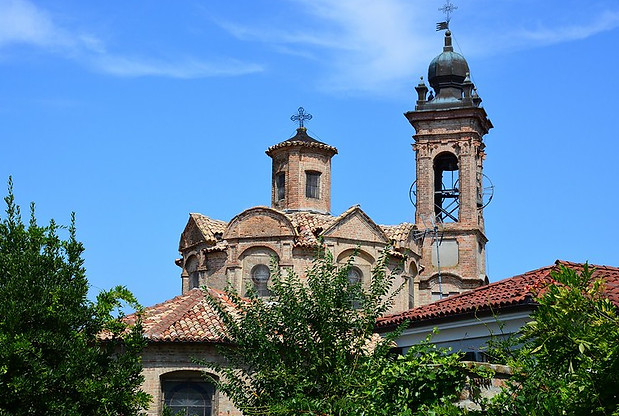
By Paul Arps-flickr
Novara
The province of Novara, an important crossroads for commercial traffic along the routes from Milan to Turin and from Genoa to Switzerland. Like Vercelli, it is also a leading rice producers .
The city of Novara, capital of the province, can be divided into two groupings. The city's most important sights lie within its historic centre, the area once enclosed by the city walls. However, several important sights also lie outside the line of the former city walls. The most imposing monument in the city is the Basilica of San Gaudenzio, with a cupola 121 metres high, constructed in 1888. The bell tower is also of particular interest.
Serravalle Scrivia
Serravalle Scrivia is a city in the Province of Alessandria, and has the biggest Facctory Outlet in Italy!

By Go Travelling, Public Domain
Val d’Ossola
Val d’Ossola is carved by the Toce River, whose source lies in Val Formazza and, overlooking a plunge of over 400 meters, to the most beautiful and powerful waterfall in the Alps. The Cascata del Toce is a stunning and mesmerising waterfall, a must-see attraction for anyone visiting the area.

Cascata del Toce
By Antontn-wikimedia.org
The Lake District in Verbano-Cusio-Ossola
The Province of Verbano Cusio Ossola lies in the northeastern strip of Piedmont, on the borders of Switzerland and Lombardy. This region awaits visitors to its many natural treasures; idyllic, peaceful mountain scenery, breathtaking panoramas, verdant pastures, unspoilt lakes and extensive system of valleys. Every valley offers exploratory excursions to discover the architecture and cultural. Among the pearls that make this environment unique are the little Lake Mergozzo, Lake Orta, and the western bank of Lake Maggiore , the most sought-after tourist resort, that hosts renowned resorts like Cannobio, Cannero Rivier, Baveno, Stresa and Verbania, capital city of the province.
Lake Orta
Picturesque views are also a feature of Lake Orta, a tranquil and serene small lake, surrounded by woods and hills, with a picturesque setting of Island of San Giulio sitting in the middle of it. The northern bank lies the historic village of Omegna, where the coffee maker and the pressure cooker were invented in the last century, is also a town worth seeing.
Stresa
Stresa, full of important architectural examples, in particular the marvelous Villa Ducale, surrounded by beautiful lawns and gardens, with an enchanting view of the Borromean Islands, especially Isola Bella, dominated by the majestic Palazzo Borromeo.
Verbania
Verbania, the capital of the province Verbano Cusio Ossola, is an ideal, relaxed setting on the shores of Lake Maggiore. This lovely lakeside city is known as “the garden on the lake” boasting the renowned 19th century mansions like Villa Taranto, whose botanic gardens are among the best known and most visited in Europe, Villa San Remigio and Villa Giulia .
Vercelli
The Province of Vercelli lies in northeastern Piedmont, extending along the Sesia River from Monte Rosa to the Po River, through the Baragge and flatlands. A spectacular panorama of rice paddies characterize Vercelli, one of Europe’s leading rice producers: rows of poplar trees divide the plain symmetrically, submerged for most of the year and reflecting the sky's many colors and hues.
Vercelli city, the capital of the province, is dominated by the imposing Romanesque-gothic Basilica di Sant'Andrea, and by the Duomo with its high Medieval bell tower.
Among the various attractions that should not be passed over is the Borgogna Museum, a collection of the most important artworks in Piedmont; its paintings date from the Renaissance to the 1800s.
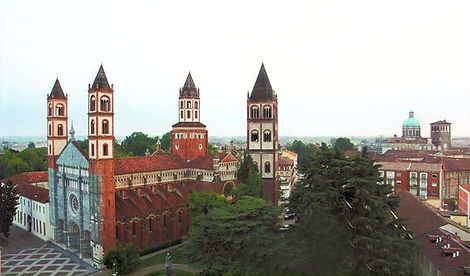
Basilica di Sant' Andrea
By Blusea2001 -wikimedia.org

Duoma
By Blusea2001 -wikimedia.org
Vineyard Landscape of Piedmont: Langhe, Roero and Monferrato
UNESCO World Hertage Site
Vineyard Landscape of Piedmont: Langhe, Roero (Province of Cuneo) and Monferrato (Province of Asti)
The hilly landscapes of the Langhe, Roero and Monferrato, with villages and castles pearching on a succession of gentle slopes, planted with rows of vine. This breathtakingly dramatic landscapes of Piemont wine growing area is celebrated for producing world-renowned wines from ancient grape varieties. It has been recognised as UNESCO World Heritage Site in 2014.
Sacred Mountains (Scari Monti of Piedmont and Lombardy)
UNESCO World Hertage Site
The Sacri Monti of Piedmont and Lombardy are groups of chapels and other architectural created in the late 16th and 17th centuries, as places of pilgrimage. There is a total of nine holy mountains known as the Sacred Mountains or Sacri Monti scattered around Lombardy and Piedmont. In Lombardy, there are two Sacred Mountains, one in Varese and the other in Ossuccio, while the remaining seven are on the Piedmontese territory. The Scared Mountains have been included in the Unesco World Heritage Site list since 2003.
The nine Sacri Monti included in the World Heritage Sites are:
-
The Sacro Monte of Nuova Gerusalemme (New Jerusalem) of Varallo Sesia (1486), Varallo Sesia, province of Vercelli (Piemont)
-
The Sacro Monte of Santa Maria Assunta, Serralunga di Crea (1589), province of Alessandria (Piemont)
-
The Sacro Monte of San Francesco, Orta San Giulio (1590), province of Novara (Piemont)
-
The Sacro Monte of the Blessed Virgin, Oropa (1617), province of Biella (Piemont)
-
The Sacro Monte of the Holy Trinity, Ghiffa (1591), province of Verbano-Cusio-Ossola (Piemont)
-
The Sacro Monte and Calvary, Domodossola (1657), province of Verbano-Cusio-Ossola (Piemont)
-
The Sacro Monte of Belmonte, Valperga (1712), Metropolitan City of Turin (Piemont)
-
The Sacro Monte of the Rosary, Varese (1598) (Lombardy)
-
The Sacro Monte of the Blessed Virgin of Succour, Ossuccio (1635), province of Como (Lombardy)
The Sacro Monte of New Jerusalem of Varallo Sesia
Sacro Monte di Varallo overlooking the town of Varallo Sesia in the province of Vercelli. It is the oldest
Sacro Monte, founded in 1491 by Franciscan prist Bernardino Caimi. It was built on a natural terrace on the rocky slopes of Monte Tre Croci ("three crosses mountain"), on the left bank of the Sesia river where it leaves Val Mastallone. It is 600 m above sea level. It comprises the basilica and 45 chapels. It is listed as UNESCO World Heritage Site under the nine Sacri Monti (Sacred Mountains) places of worship.
The Sacro Monte di Crea
The Sacro Monte di Crea is a Roman Catholic sanctuary in the comune of Serralunga di Crea, in province of Alessandria. It is reached via a steeply ascending route which winds through a wooded natural park. It is listed as UNESCO World Heritage Site under the nine Sacri Monti (Sacred Mountains) places of worship.
Sacro Monte di Orta
The Sacro Monte di Orta is a Roman Catholic devotional complex in the comune of Orta San Giulio , in the province of Novara on the summit of a hill known as San Nicolao, which faces the western shore of Lake Orta. It is one of the Sacri Monti of Piedmont and Lombardy, included in UNESCO World Heritage list.
Sacro Monte di Oropa
The Sacro Monte di Oropa is a Roman Catholic devotional complex in the province of Biella. It is one of the nine Sacri Monti of Piedmont and Lombardy and is on the UNESCO World Heritage list.
Sacred Mountain of Ghiffa
The Sacred Mountain of Ghiffa, another Roman Catholic devotional complex in the comune of Ghiffa, in the province Verbano Cusio Ossola , overlooking the Lake Maggiore. It is also one of the nine Sacri Monti of Piedmont and Lombardy included in UNESCO World Heritage list.
Sacro Monte di Calvary
One of the most beautiful tourist attractions of Domodossola is the Sacro Monte Calvary, in the province Verbano Cusio Ossola, stands on the Mattarella Hill in a dominant position above the Toce valley, with a view over the whole of Domodossola and the surrounding mountains. It is listed as a UNESCO World Heritage Site under The Sacri Monti (Sacred Mountains) places of worship.
Sacro Monte di Belmonte
The Sacro Monte di Belmonte is a Roman Catholic devotional complex in the comune of Valperga, in the Metropolitan City of Turin. It is one of the nine Sacri Monti of Piedmont and Lombardy, included in UNESCO World Heritage list.
Prehistoric Pile Dwellings around the Alps
Near Lake Viverone and Azeglio, in the Canavese area, are part of the The Prehistoric Pile Dwellings around the Alps UNESCO World Heritage Sites.
Lake Azeglio (Province of Turin) is home to one or more prehistoric pile dwelling settlements and Lake Viverone (Province of Biella) , is also an important archaeological site with villages made up of stilt houses were present here in the Bronze Age (2000–1000 B. C.).
Truffle Hunting
The truffles are located by a dedicated network of truffle hunters or 'trifulau' who search for them with their trusted dogs. What better way to learn about the history and art of truffle hunting than to go on a hunt yourself? Head out into the countryside accompanied by an expert truffle hunter and his trusted dogs in search of the treasured delicacy.

By Andrea Cairone - Unsplash

By pixelia -Pixabay















